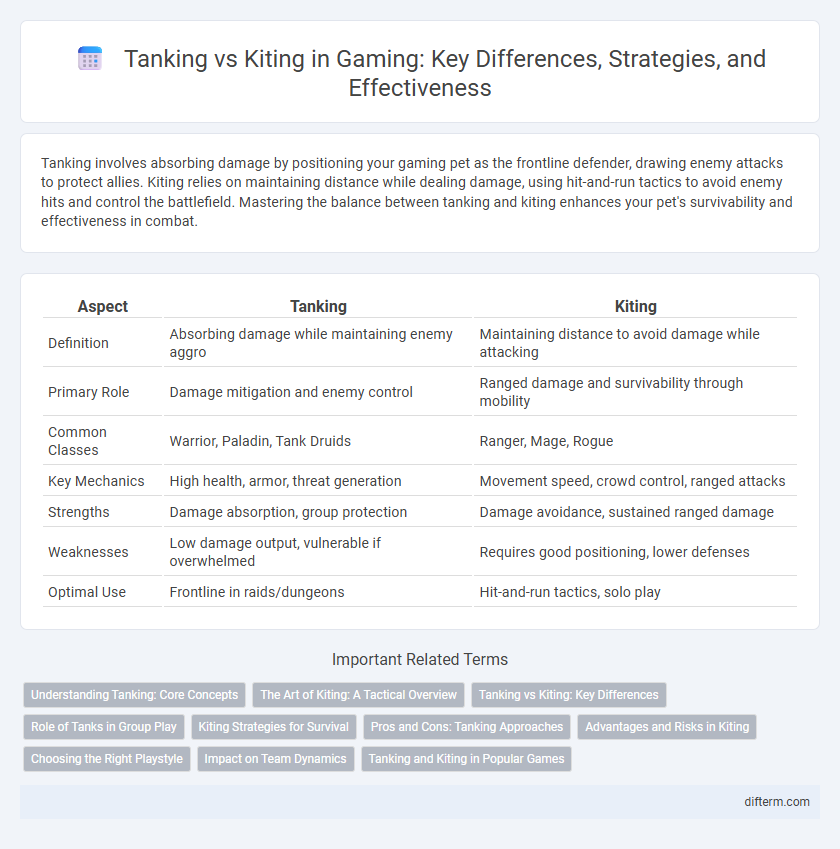Tanking involves absorbing damage by positioning your gaming pet as the frontline defender, drawing enemy attacks to protect allies. Kiting relies on maintaining distance while dealing damage, using hit-and-run tactics to avoid enemy hits and control the battlefield. Mastering the balance between tanking and kiting enhances your pet's survivability and effectiveness in combat.
Table of Comparison
| Aspect | Tanking | Kiting |
|---|---|---|
| Definition | Absorbing damage while maintaining enemy aggro | Maintaining distance to avoid damage while attacking |
| Primary Role | Damage mitigation and enemy control | Ranged damage and survivability through mobility |
| Common Classes | Warrior, Paladin, Tank Druids | Ranger, Mage, Rogue |
| Key Mechanics | High health, armor, threat generation | Movement speed, crowd control, ranged attacks |
| Strengths | Damage absorption, group protection | Damage avoidance, sustained ranged damage |
| Weaknesses | Low damage output, vulnerable if overwhelmed | Requires good positioning, lower defenses |
| Optimal Use | Frontline in raids/dungeons | Hit-and-run tactics, solo play |
Understanding Tanking: Core Concepts
Tanking in gaming involves absorbing damage and maintaining enemy aggro to protect teammates, utilizing high health pools, defensive stats, and crowd control abilities. Effective tanking requires positioning to intercept attacks and managing threat generation through abilities like taunts and damage-dealing skills. Mastery of tanking enhances team survivability by controlling enemy focus and reducing damage taken by squishier party members.
The Art of Kiting: A Tactical Overview
Kiting in gaming involves maintaining optimal distance while continuously dealing damage to enemies, effectively controlling their movements and minimizing incoming damage. Mastering kiting requires precise timing, superior positioning, and situational awareness to evade attacks while exploiting enemy vulnerabilities. This tactical approach often outperforms traditional tanking by maximizing damage output and survivability through mobility and strategic disengagement.
Tanking vs Kiting: Key Differences
Tanking involves absorbing damage and maintaining enemy attention through high durability and threat generation, making it essential for protecting allies in close combat scenarios. Kiting emphasizes ranged attacks while maintaining distance to avoid damage, relying on mobility and crowd control to manage enemy positioning effectively. Understanding these key differences helps players optimize their roles based on the desired playstyle and tactical needs in gaming environments.
Role of Tanks in Group Play
Tanks play a crucial role in group play by absorbing damage and maintaining enemy focus, enabling damage dealers and healers to perform their roles effectively. Their ability to manage threat and control positioning reduces the risk of group-wide damage and interruptions. Mastery of tanking techniques, such as threat generation and cooldown management, is essential for steady group progression in raids and dungeons.
Kiting Strategies for Survival
Kiting strategies in gaming emphasize maintaining distance from enemies while continuously dealing damage, effectively minimizing incoming damage and maximizing survivability. Utilizing movement abilities, crowd control effects, and terrain advantages enables players to control the pace of combat and avoid heavy hits from tanky opponents. Mastering kiting requires precise positioning, timing, and awareness of enemy cooldowns to successfully outmaneuver foes and sustain longer in battle.
Pros and Cons: Tanking Approaches
Tanking approaches in gaming involve absorbing damage and maintaining enemy focus, which allows teammates to deal consistent damage safely, enhancing overall team survivability. Tanking ensures crowd control and positional advantage but often results in slower movement and higher damage intake, making tanks susceptible to burst damage. The effectiveness of tanking depends on strong defensive stats, reliable threat generation, and coordination with the team to mitigate the high-risk exposure.
Advantages and Risks in Kiting
Kiting in gaming offers the advantage of controlling enemy movement, allowing players to deal damage while minimizing direct hits and reducing risk of health loss. It provides strategic positioning benefits, enabling continuous attack without enemy retaliation, which is crucial in classes with ranged abilities. Risks in kiting include increased reliance on player skill and timing, potential vulnerability to area-of-effect attacks, and the possibility of losing aggro if not managed properly.
Choosing the Right Playstyle
Choosing the right playstyle in gaming depends on the character's role, mobility, and team composition. Tanking involves absorbing damage and maintaining enemy aggression, ideal for players who thrive in close combat and high durability. Kiting emphasizes hit-and-run tactics and crowd control, suitable for players prioritizing agility and ranged attacks to outmaneuver opponents.
Impact on Team Dynamics
Tanking absorbs enemy damage, allowing teammates to deal damage safely and maintain offensive pressure during battles. Kiting controls enemy movement and spacing, enabling ranged allies to maximize damage while minimizing risk. Balancing tanking and kiting strategies enhances team survivability and optimizes crowd control effectiveness in dynamic combat scenarios.
Tanking and Kiting in Popular Games
Tanking and kiting are crucial gameplay strategies in popular games like World of Warcraft, League of Legends, and Final Fantasy XIV. Tanking involves absorbing and mitigating damage to protect teammates, utilizing characters with high health and defense stats such as shields and armor. Kiting emphasizes maintaining distance from enemies while dealing damage, often using ranged attacks and mobility to control the battlefield and avoid direct confrontation.
tanking vs kiting Infographic

 difterm.com
difterm.com